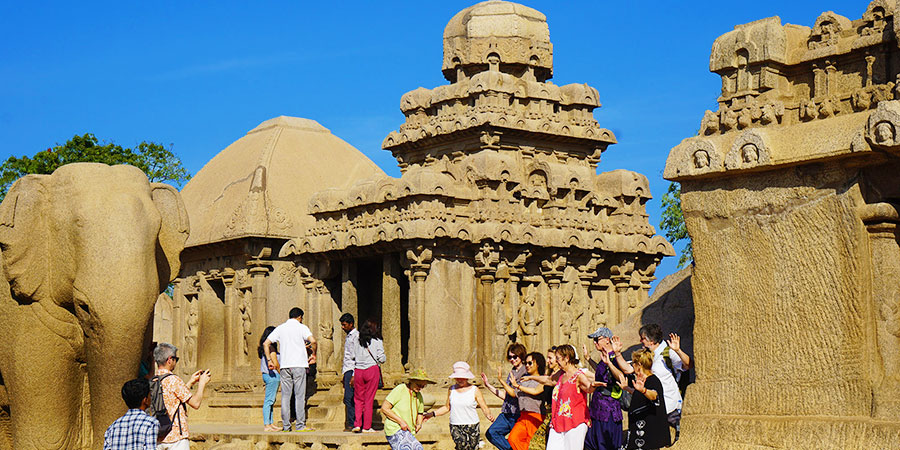Pancha Rathas in Mahabalipuram
One of the most famous monument complexes at Mahabalipuram is Panch Rathas or Five Rathas, Mahabalipuram. What was once a major seaport during the Pallava dynasty is now recognised as an UNESCO World Heritage Site. This five rock marvels are monolithic rock temples which are shaped as chariots. They have bas-relief sculptures constructed on it and are a majestic representation of ancient India's architectural prowess. You have to visit the southernmost extreme of Mahabalipuram to experience these amazing structures.The Mahabalipuram Pancha Rathas are named after the five Pandavas - Yudhistara, Arjuna, Bhima, Nakula & Sahadeva and their wife Draupadi. Along with the rathas, you will also find the lion (the vehicle of Durga), an elephant statue (the vehicle of Indra) and Nandi bull (the vehicle of Shiva). Interestingly, even though these structures are named according to the mythological characters, it is not linked with the Mahabharata. Pallava ruler Narsimha Varman 1 (AD 630- 68) commissioned this construction which was built in the 7th and 8th centuries.
Did you know that most of these Pancha Rathas, Mahabalipuram are incomplete in construction?

|
The Reason behind the Construction
There is no known reason why these rathas were constructed but you can certainly find a reflections of the Buddhist Chaityas and Viharas. According to the ASI, the structures have been referred to as vimanas, however, till date, the names of Pandavas are associated with the structures. This place was recognised as an UNESCO World Heritage Site in 1984.Looking at Each Rathas
• Dharmaraja Ratha
It is possibly the most architecturally imposing structure out of the other five. In fact, it is also the largest which is dedicated to Lord Shiva. The intricately designed and sculptured tritala or three-storied viman will create a consecrated ambience. It measures 8.5m (28ft) by 11m (36ft). two pillars and two pilasters make up the facades of the ratha. The pyramidal tower have a terrace and a shikhara that is basically of an octagonal shape at the apex.There are many small structures adorning the interior of the ratha. Ardhanarisvara, Brahma-Sasta, Harihara, different forms of Shiva, Krishna, and Skanda are some of them.
You can find projections in the shape of kudus or horseshoe-arch dormer on the upper portion of the structure. The other impressive mythological and historical sculptures in the ratha includes Lord Krishna dancing atop Kaliya Mardhana, Dakshinamurthy and Somaskanda.
• Bhima Ratha
This structure measures 12.8m (42ft) by 7.3m (24ft) with a height of 7.6m (25ft). This oblong structure faces westwards and has a strong resemblance to the Buddhist cave architecture, Sala-Shikhara. This structure is dedicated to Lord Vishnu and boosts of a palatial architectural style.A barrel-vaulted terrace in the ratha has a pink granite boulder that runs from north to south. The lower part of the vimana is not entirely constructed but the structure shows the plan had a pillar-rested circumambulatory passage. There are inscriptions of Nasikas in the interior of the vimana.
• Arjuna Ratha

|
A pillared Mukhamandapa or inner porch in place in the garbhagriha or sanctum sanctorum. You can find two lion mounted carved pilasters at the entrance of the ratha which is seated on two pillars. Kudus decorate the sides of the cornices and a simple Padabandha style is seen around the main deity. The other figurines you can find here includes Siva-Vrishabhantika, Skanda, and Vishnu with apsaras, a Chowri bearer, Parthiharas, Amaras and more.
The rear of the ratha has Lord Shiva’s mount, Nandi the bull.
• Nakula Sahadeva Ratha
This ratha is named after the twins Nakula and Sahadeva and is the only ratha among the five that faces south. Many find it resembling the Chaitya Hall of a Buddhist prayer hall. The structure mirrors the rear side of an elephant, which is why is referred as ‘Gajaprishtakara’ (the style is called ‘gajapristha’).This chariot is constructed on the same base as that of the Dharmaraja, Bhima and Arjuna rathas, and has an apsidal plan. Interestingly, you will not find any idol to worship but the interiors are carved with sculptures of gods and demi-gods.
• Draupadi Ratha
Draupadi was the common wife of the five Pandavas.This chariot is located at the northern end and is dedicated to Goddess Durga. You can find a similarity in the construction of that of a small hut of Bengal. Also, this is smallest of the Mahabalipuram Pancha Rathas, measuring 3.4m (11ft) by 3.4m and is at a height of 5.5m (18ft). There are many motifs in the joints and has a high rise platform at the entrance door of the west. The sculptures of elephant and lion heads are chiselled alternately. The ratha is adorned by Durga images and the sanctorum has Goddess Durga on the east standing on a lotus.
When to Visit Pancha Rathas, Mahabalipuram
The ideal time to visit the Mahabalipuram Rathas, is from December to March. You cannot ignore the architectural brilliance of the time.The entry fee per person is Rs.10 for Indian citizens and Rs. 250 for foreigners.
The closest railhead from Mahabalipuram is Chengalpattu (29 km, 18 miles). Chennai is 48 km (30mi) away from the place. The roadways connect the major Indian cities from the place.

